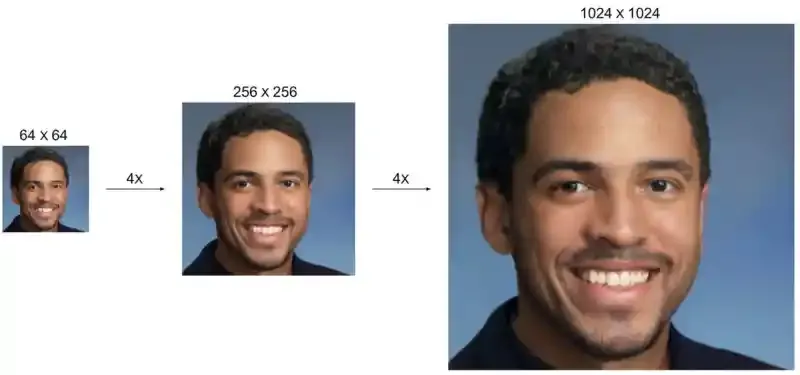
Google is on a route to provide us numerous picture upscaling diffusion techniques.
- The super Resolution (SR3)
- and Cascaded Diffusion Models(CDM) for class-conditioned synthesis (CDM)
You're almost there, comprehending the most modern notions of artificial intelligence Google Photo upscaling technology.
The Google Ai photo upscaling technology is excellent!
Those communities that grew around the 90s may have captured hundreds of images with their Kodak or action camera during ceremonies, weddings, scenarios, or with coworkers. Regardless, there was no such thing as a quality camera at the time, such as today's DSLR or smartphone. Most of us had taken photos using our old cameras and taped them on a wall or a rill.
What if you could turn these vintage photos into modern ones?
Yes, Google will provide us with new artificial intelligence or AI-powered technologies that can transform your abandoned low-resolution rough image into fantastic high-resolution photos.
On the other hand, Google discussed and developed the diffusion models in 2015, and after several years of research, they have recently received renewed interest in photo upscaling. People start experimenting with Adobe Photoshop and other techniques to transform their low-resolution photographs. As a result, Google provides potentially useful technology to improve photo quality synthesis. Deep generative models, such as GANs, VAEs, and autoregressive models, are typically used to accomplish picture synthesis tasks. Google claims that
Diffusion models function by corrupting the training data with Gaussian noise, gradually wiping out subtleties in the data until it is pure noise, and then training a neural network to reverse this corruption process. This reversed corruption approach creates data from pure noise by gradually denoising it until a clean sample is created. This synthesis technique may be thought of as an optimization algorithm that produces probable samples by following the gradient of the data density.
What exactly is super Resolution 3 (SR3) diffusion?

SR3, or the image super-resolution diffusion model, accepts a low-resolution picture as input and generates a complementary high-resolution image from pure noise.
The model includes an image corruption technique that gradually expands noise to a high-resolution image until only pure noise remains. It also demonstrates how to reverse this approach by starting with pure noise and gradually decreasing noise to expand a target diffusion through the guidance of the input low-resolution image.
For portrait, face, and natural images,super-resolution or SR3 performed a tremendous duty and claimed a strong benchmark result. Then,super-resolution models can further be cascaded together to increase the effective super-resolution scale factor, e.g., stacking a 64x64 → 256x256 and a 256x256 → 1024x1024 face super-resolution model together to perform a 64x64 → 1024x1024 super-resolution task.
Cascaded Diffusion Models (CDM)
The second step to enhance photo quality is Cascade diffusion models (CDM). After getting a great positive benchmark on the super-resolution, they step out to test cascaded diffusion models. Cascaded diffusion models can generate high fidelity images on the class-conditional ImageNet generation challenge without any assistance from auxiliary image classifiers to boost sample quality.
A cascaded diffusion model comprises a pipeline of multiple diffusion models that generate images of increasing resolution, beginning with a standard diffusion model at the lowest resolution, followed by one or more super-resolution diffusion models that successively upsample the image and add higher resolution details.
In case you're looking forward to it!
Difference between (SR3) and (CDM):
There is no such difference between super-resolution(SR3) and cascaded diffusion models (CDM). These are further steps to enhance image upscaling quality. Google began to provide image upscaling step by super-resolution diffusion, and after seeing that positive result, they introduced cascaded diffusion modules to enhance picture quality.
Google will also introduce a new data augmentation technique called conditioning augmentation, which will further improve the sample quality results captured by CDM.
With these two artificial intelligence diffusion, Google tries to push the performance of diffusion models to the state-of-the-art on super-resolution and class-conditional ImageNet generation benchmarks. They try to test solving image resolution and noise by implementing further steps to get high-quality images. To get more information about Google photo upscaling technology, read the entire blog on ai Google blogs.
What is an enlarged image?
An enlarged image is a mechanism that increases the size of pixels sizes of an image. If your image has insufficient resolution pixels, it could become pixelated when zoomed or increased in size. Still, a high-resolution image will not lose quality when zoomed or increased in size. The image enlargement procedure, such as Upscalepics on1resize, uses artificial intelligence machine learning techniques to automatically add a huge number of pixels, remove image distortions, and add some extra brightness, textures, and tones, resulting in enlarged, high-quality photos.
If you wish to test out some of the free picture enlarger software currently accessible, visit the image enlarger websites listed below.
How machine learning works?
Before we can understand how machine learning works, we must first understand what machine learning is.
Machine learning is an area of artificial intelligence, sometimes known as AI. It also has a subject called deep learning, which many of us have heard of. Machine learning is a branch of computer science that is increasingly concentrating on the accuracy of data and algorithms. It has a large number of classifications and is a rising subject in data science.
Due to the growing relevance of big data, critical insights, and data mining projects, the demand for data scientists will rise in the next years. Machine learning actually operates in three separate ways,
- First, it gathered all of the information, data, and labeled or unlabeled input in the decision process, and then the algorithm estimated a data pattern.
- In the next section, it began to make accuracy while checking the error function and evaluating the models' predictions.
- Finally, it began optimizing models by automatically changing the weights until they fit for accuracy in data point training.

